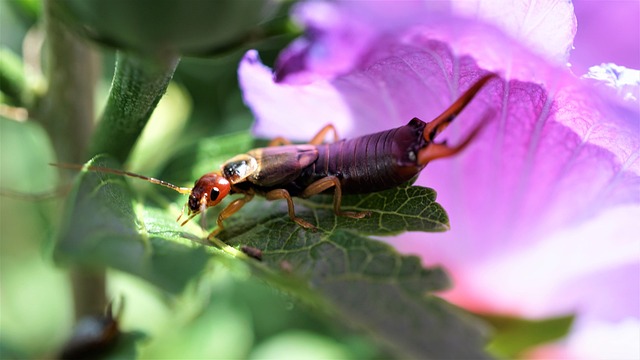Earwig infestations often go unnoticed until signs like small holes in fabrics, musty odors, and gatherings in dark, humid areas appear. To address these pests effectively, consider earwig pest control measures such as sealing entry points, maintaining cleanliness, using sticky traps, or essential oil repellents, and seeking professional treatments if necessary. Regular prevention strategies include sealing gaps and cracks, inspecting for moisture buildup, using natural repellents, and planting marigolds or lavender near potential access points.
“Uncover the subtle signs of an earwig infestation and take back your space! This comprehensive guide equips you with the knowledge to identify these tiny invaders and their destructive habits. From recognizing common symptoms like damaged plants and odd noises to understanding their preferred habitats, you’ll learn effective strategies for earwig pest control. We offer practical tips on prevention, ensuring a future free from these pesky critters. Say goodbye to earwigs and reclaim your environment with our expert advice on earwig pest control.”
Identifying Earwig Infestation: Common Signs and Symptoms
Earwig infestations can often go unnoticed until they reach significant levels, making it crucial to be aware of common signs and symptoms. One of the earliest indicators is the presence of small holes in your fabrics, especially delicate items like curtains, bedding, or clothing. These pests are also known for leaving behind a distinct scent, described as a musty or earthy odor, which can be detected around affected areas.
Additionally, earwigs tend to prefer dark and humid spaces, so you might observe them gathering in kitchens, bathrooms, or other moist parts of your home. Keep an eye out for small, brown insects scurrying along walls, under furniture, or in potted plants. If you notice any of these signs, it’s time to consider earwig pest control measures to address the infestation effectively.
Understanding the Behavior and Habitat of Earworms
Earwigs, despite their unsettling name and appearance, are a common household pest. Understanding their behavior and habitat is crucial in addressing an earwig infestation effectively. These insects prefer dark, humid environments and are often found in areas like basements, crawl spaces, and bathrooms. They are nocturnal creatures, actively seeking out cracks and crevices to hide during the day and emerge at night to forage for food.
Earwigs feed on a variety of organic materials, including plants, fruits, vegetables, and even dead insects. Their presence can go unnoticed for some time, but signs like small holes in clothing or curtains, chewed plant material, and an odd scent may indicate an infestation. To implement earwig pest control, it’s essential to seal entry points, maintain a clean environment, and consider professional treatments if the problem persists.
Effective Strategies for Earwig Pest Control
Earwig pest control is a multifaceted approach that combines prevention, inspection, and targeted treatments. The first line of defense involves sealing entry points by filling cracks and gaps around windows, doors, and utility pipes with caulk or weatherstripping. Regularly trimming vegetation and removing debris from around the home can also hinder their access.
For existing infestations, a combination of non-toxic methods can be effective. Sticky traps placed near potential hiding spots like baseboards and under furniture can capture adult earwigs. Soaps and oils derived from essential plants like peppermint or lavender can act as natural repellents when applied to problem areas. In severe cases, professional pest control services offering safe, targeted treatments may be necessary to eradicate the infestation completely.
Prevention Measures to Avoid Future Infestations
To prevent future earwig infestations, consider implementing several proactive measures. Start by sealing any gaps or cracks in your home’s exterior, especially around windows, doors, and utility pipes. Earwigs are known to enter through tiny openings, so regular inspections and repairs can significantly reduce their access points. Additionally, maintain a clean and tidy environment, especially in areas prone to moisture buildup, as earwigs are attracted to humid spaces. Regularly vacuum and dust your home, and ensure food waste is properly secured and disposed of.
Another effective strategy is to use natural repellents like mint, cinnamon, or cloves around entry points. These strong scents can deter earwigs from entering. Additionally, keeping plants like marigolds or lavender near potential access points might help as they are known to repel various pests. Regular earwig pest control measures, such as professional treatments and the use of earwig traps, can also be preventive, ensuring your home remains uninvitable to these insects.
Earwig infestations can be a nuisance, but with proper identification and swift action, you can effectively address and prevent them. By recognizing the common signs outlined in this article, understanding these pests’ behavior, and implementing the suggested earwig pest control methods, you can reclaim your living or working space. Regular prevention measures will further ensure these critters don’t make a comeback. Remember, quick response is key to managing earwig infestations successfully.
